重庆医科大学:《病理学》课程教学实习指导(英文)
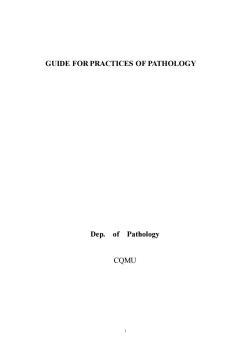
GUIDE FOR PRACTICES OF PATHOLOGY Dep.of Pathology CQMU
1 GUIDE FOR PRACTICES OF PATHOLOGY Dep. of Pathology C CQMU
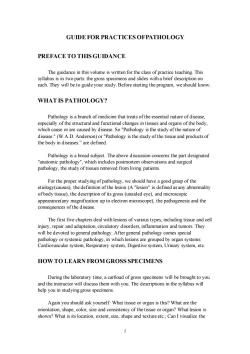
GUIDE FOR PRACTICES OFPATHOLOGY PREFACE TO THIS GUIDANCE The guidance in this volume is written for the class of practice teaching.This syllabus is in two parts:the gross specimens and slides witha brief description on each.They will be to guide your study.Before starting the program,weshould know WHAT IS PATHOLOGY? Pathology is a branch of medicine that treats of the essential nature of disease. especially of the structural and functional changes in tissues and organs of the body which cause or are caused by disease.So"Pathology is the study of the nature of disease."(W.A.D.Anderson)or"Pathology is the study of the tissue and products of the body in diseases are de ine Pathology is a broad subject.The above discussion concers the part designated "anatomic pathology".which includes postmortem observations and surgical pathology,the study of tissues removed from living patients. For the n ner studving of nathology we should have a ood g on ofthe lesion (A"lesion"is defi asp of the s),the definiti ined as any abnormality the deseniption oft(umed ve)and micnsoon appearance(any magnification up to electron microscope),the pathogenesis and the consequences of the disease. The first five chapters deal with lesions of various types,including tissue and cell injry,repair and adaptaondisodrs inflammation andmrs.y general pathology. general pathology omes special ch les ons are grouped by organ systems: HOW TO LEARN FROM GROSS SPECIMENS During the laboratory time a cartload ofg pecimens will be brought to you and the ill discuss them with you. The descriptions in the syllabus will help you in studying gross specimens Again you should ask yourself:What tissue or organ is this?What are the orientation,shape,color,size and consistency of the tissue or organ?What lesion is shown?What is its location,extent,size,shape and texture etc.;Can I visualize the 2
2 GUIDE FOR PRACTICES OF PATHOLOGY PREFACE TO THIS GUIDANCE The guidance in this volume is written for the class of practice teaching. This syllabus is in two parts: the gross specimens and slides with a brief description on each. They will be to guide your study. Before starting the program, we should know: WHAT IS PATHOLOGY? Pathology is a branch of medicine that treats of the essential nature of disease, especially of the structural and functional changes in tissues and organs of the body, which cause or are caused by disease. So "Pathology is the study of the nature of disease." (W.A.D. Anderson) or "Pathology is the study of the tissue and products of the body in diseases.” are defined. Pathology is a broad subject. The above discussion concerns the part designated "anatomic pathology", which includes postmortem observations and surgical pathology, the study of tissues removed from living patients. For the proper studying of pathology, we should have a good grasp of the etiology(causes), the definition of the lesion (A "lesion" is defined as any abnormality of body tissue), the description of its gross (unaided eye), and microscopic appearance(any magnification up to electron microscope), the pathogenesis and the consequences of the disease. The first five chapters deal with lesions of various types, including tissue and cell injury, repair and adaptation, circulatory disorders, inflammation and tumors. They will be devoted to general pathology. After general pathology comes special pathology or systemic pathology, in which lesions are grouped by organ systems: Cardiovascular system, Respiratory system, Digestive system, Urinary system, etc. HOW TO LEARN FROM GROSS SPECIMENS During the laboratory time, a cartload of gross specimens will be brought to you and the instructor will discuss them with you. The descriptions in the syllabus will help you in studying gross specimens. Again you should ask yourself: What tissue or organ is this? What are the orientation, shape, color, size and consistency of the tissue or organ? What lesion is shown? What is its location, extent, size, shape and texture etc.; Can I visualize the

micr opic appearal e of this lesion?What caused the lesion shown here?What were the stages in pathogenesis of this lesion?What were the cons sequences of this lesion?What other related lesions might this patient have?Prevention WHAT IS THE PROCEDURE TODEAL WITHAND HOWTO LEARN FROMA SLIDE When you read microscopic slides,you should take the following steps Hold the slide up and look at it with the unaided eyes first.This procedure is an important aid in orientation and locating important fields to be studied microscopically such as a necrotic area.a localized tumor or an area of hemorrhage This step might give you acoarse impression of features of the lesion shape.size. tinctorial v iatio defects or changes in tissue Take out one eye piece.reverse it,hold its top lens against the slide,and get your eye close to the other end.This will give you a 10x view and will reveal many features of value. SECTION SIDE IS UP:Otherwise,when you go to high magnification,you will not be able to focus and will tend to force down the lens and crack theslide. Every slid ew,but the tissue taken from the patientscan not be evaluated by cost,and if the slide or lens is destroyed,you should pay extra fee. Low magnification(8-10x objective)is the most important power to survey the slide and to examine every bit of the tissue.You should leamn to identify tissues,types of exudate and tumors at this power. The high d ry powe r(40-50x objective)is sufficient tostudy most detail such as cell typesor interstitial substances. To understand slides,ask yourself:What tissue is this(may be more than one)? What are the lesions (often more than one)?Have I missed any features?How did this lesion develop?What cause it?What would occur here in the future?What other related lesion(s)would this patient have?How could the lesion(s)here have beer prevented?Can I visualize the gross appearance ofthis lesion? Inorder to learn rapidly from a slide it is important to know what one look fo Hence it is almost essential to have at hand a textbook which includes microscopic detail and which can be consulted before or during the study of a slide.It is of equal importance to make some notation of what one has observed on each slide.This may be in the form of a description as above,a brief outline,or a semidiagrammatic abeled sketch.Asa preliminary step to any ofthese notes,it may be ofhelp tomake
3 microscopic appearance of this lesion? What caused the lesion shown here? What were the stages in pathogenesis of this lesion? What were the consequences of this lesion? What other related lesions might this patient have? Prevention? WHAT IS THE PROCEDURE TO DEAL WITH AND HOW TO LEARN FROM A SLIDE ? When you read microscopic slides, you should take the following steps: Hold the slide up and look at it with the unaided eyes first. This procedure is an important aid in orientation and locating important fields to be studied microscopically such as a necrotic area, a localized tumor or an area of hemorrhage. This step might give you a coarse impression of features of the lesion shape, size, tinctorial variation, defects or changes in tissue. Take out one eye piece, reverse it, hold its top lens against the slide, and get your eye close to the other end. This will give you a 10× view and will reveal many features of value. SECTION SIDE IS UP: Otherwise, when you go to high magnification, you will not be able to focus and will tend to force down the lens and crack the slid e. Every slide costs few, but the tissue taken from the patients can not be evaluated by cost, and if the slide or lens is destroyed, you should pay extra fee. Low magnification (8-10× objective) is the most important power to survey the slide and to examine every bit of the tissue. You should learn to identify tissues, types of exudate and tumors at this power. The high dry power (40-50× objective) is sufficient to study most detail such as cell types or interstitial substances. To understand slides, ask yourself: What tissue is this (may be more than one)? What are the lesions (often more than one)? Have I missed any features? How did this lesion develop? What cause it? What would occur here in the future? What other related lesion(s) would this patient have? How could the lesion(s) here have been prevented? Can I visualize the gross appearance of this lesion? In order to learn rapidly from a slide it is important to know what one look for. Hence it is almost essential to have at hand a textbook which includes microscopic detail and which can be consulted before or during the study of a slide. It is of equal importance to make some notation of what one has observed on each slide. This may be in the form of a description as above, a brief outline, or a semidiagrammatic labeled sketch. As a preliminary step to any of these notes, it may be of help to make
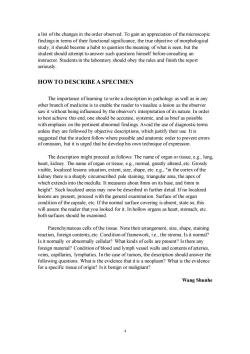
a list of the changes in the order observed.Togain an appreciation of the microscopic of their functional signific nce,the true study,It student should attempt to answer such questions himself before consulting an instructor.Students in the laboratory should obey the rules and finish the report seriously. HOWTO DESCRIBE A SPECIMEN The importance of learning to write a description in pathology as well as in any other branch of medicine is to enable the reader to visualize a lesion as the observer saw it without being influenced by the observer's interpretation of its nature.In order to best achieve this end one should be accurate.systemic.and as brief as possible phasis on the pertinent abnormal findings.Avoid the use of dia agnostic terms thev r followed byobve desciptons which utify their Is suggested that the student follow where possible and anatomic order to prevent errors of omission,but it is urged that he develop his own technique of expression. The description might proceed as follows:The name of organ or tissue.e.g.lung heart kidney The name oforga or tissue,e.g.n ormal altered,ete.Grossly zisible localized lesi ssitu greatly ent nape, etc. ortex c of the kidney there is a sharply circumscribed pale staining triangular area,the apex of which extends into the medulla.It measures about 8mm on its base,and 6mm in height".Such localized areas may now be described in further detail.If no localized lesions are pres nt,proceed with the general examination.Surface of the organ overing is o this assure the reac r that you lo ked for it.In hollow organs as heart,stomach,etc both surfaces should be examined Parenchymatous cells ofthe tissue.Note their arrangement,size,shape.staining reaction,foreign contents,etc.Condition of framework,i.e.,the stroma.Is it normal? Is it normally or abnormally cellular?What kinds of cells are present?Is there any foreign material?Condition of blood and lymph vessel walls and veins,capillaries,lymphatics.In the case of tumors,the description should answer the following questions.What is the evidence that it is a neoplasm?What is the evidence for a specific tissue of origin?Is it benign or malignant? Wang Shunhe
4 a list of the changes in the order observed. To gain an appreciation of the microscopic findings in terms of their functional significance, the true objective of morphological study, it should become a habit to question the meaning of what is seen, but the student should attempt to answer such questions himself before consulting an instructor. Students in the laboratory should obey the rules and finish the report seriously. HOW TO DESCRIBE A SPECIMEN The importance of learning to write a description in pathology as well as in any other branch of medicine is to enable the reader to visualize a lesion as the observer saw it without being influenced by the observer's interpretation of its nature. In order to best achieve this end, one should be accurate, systemic, and as brief as possible with emphasis on the pertinent abnormal findings. Avoid the use of diagnostic terms unless they are followed by objective descriptions, which justify their use. It is suggested that the student follow where possible and anatomic order to prevent errors of omission, but it is urged that he develop his own technique of expression. The description might proceed as follows: The name of organ or tissue, e.g., lung, heart, kidney. The name of organ or tissue, e.g., normal, greatly altered, etc. Grossly visible, localized lesions situation, extent, size, shape, etc. e.g., "in the cortex of the kidney there is a sharply circumscribed pale staining, triangular area, the apex of which extends into the medulla. It measures about 8mm on its base, and 6mm in height". Such localized areas may now be described in further detail. If no localized lesions are present, proceed with the general examination. Surface of the organ condition of the capsule, etc. If the normal surface covering is absent, state so; this will assure the reader that you looked for it. In hollow organs as heart, stomach, etc. both surfaces should be examined. Parenchymatous cells of the tissue. Note their arrangement, size, shape, staining reaction, foreign contents, etc. Condition of framework, i.e., the stroma. Is it normal? Is it normally or abnormally cellular? What kinds of cells are present? Is there any foreign material? Condition of blood and lymph vessel walls and contents of arteries, veins, capillaries, lymphatics. In the case of tumors, the description should answer the following questions. What is the evidence that it is a neoplasm? What is the evidence for a specific tissue of origin? Is it benign or malignant? Wang Shunhe
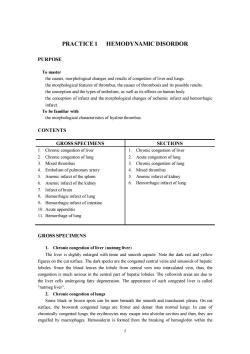
PRACTICE 1 HEMODYNAMIC DISORDOR PURPOSE To master the causes,morphological changes and results of congestion of liver and lungs. the morphological features of thrombus,of thrombosisand its possibe resuls the and the types of wella sits effectson human body the conception of infarct and the morphological changes of ischemic infarct and hemorrhagic infarct. To be familiar with the morphological characteristics of hyaline thrombus CONTENTS GROSS SPECIMENS SECTIONS 1.Chronic congestion of liver 1.Chronic congestion of liver 2.Chronic congestion oflung 3.Mixed thro Acute congestion oflung mbus Embolism of pulmonary artery Mixed thrombus 5.Anemic infarct ofthe spleen Anemic infarct of kidney 6.Anemic infarct of the kidney 6.Hemorrhagic infarct of lung 7.Infarct ofbrain 8.Hemorrhagic infarct of lung 9.Hemorrhagic infarct of 10.Acute appenditis 11.Hemorrhage of lung GROSS SPECIMENS 1.Chronic congestion of liver(nutmeg liver) The liver is slightly enlarged with tense and smooth capsule.Note the dark red and yellov figures on the cut surface.The dark specks are the congested central veins and sinusoids of hepatic lobules.Since the blood leaves the lobule from central vein into intercalated vein.thus.the congestion is much serious in the central part of hepatic lobules.The yellowish areas are due to nutmeg liver" 2.Chronic congestion oflungs Some black or brown spots can be seen beneath the smooth and translucent pleura On cut surface.the brownish congested lungs are firmer and denser than normal lungs.In case of ungs, the er m engulfed by macrophages.Hemosi erin is formed from the breaking of hemoglobin within the
5 PRACTICE 1 HEMODYNAMIC DISORDOR PURPOSE To master the causes, morphological changes and results of congestion of liver and lungs. the morphological features of thrombus, the causes of thrombosis and its possible results. the conception and the types of embolism, as well as its effects on human body. the conception of infarct and the morphological changes of ischemic infarct and hemorrhagic infarct. To be familiar with the morphological characteristics of hyaline thrombus. CONTENTS GROSS SPECIMENS SECTIONS 1. Chronic congestion of liver 2. Chronic congestion of lung 3. Mixed thrombus 4. Embolism of pulmonary artery 5. Anemic infarct of the spleen 6. Anemic infarct of the kidney 7. Infarct of brain 8. Hemorrhagic infarct of lung 9. Hemorrhagic infarct of intestine 10. Acute appenditis 11. Hemorrhage of lung 1. Chronic congestion of liver 2. Acute congestion of lung 3. Chronic congestion of lung 4. Mixed thrombus 5. Anemic infarct of kidney 6. Hemorrhagic infarct of lung GROSS SPECIMENS 1. Chronic congestion of liver (nutmeg liver) The liver is slightly enlarged with tense and smooth capsule. Note the dark red and yellow figures on the cut surface. The dark specks are the congested central veins and sinusoids of hepatic lobules. Since the blood leaves the lobule from central vein into intercalated vein, thus, the congestion is much serious in the central part of hepatic lobules. The yellowish areas are due to the liver cells undergoing fatty degeneration. The appearance of such congested liver is called "nutmeg liver". 2. Chronic congestion of lungs Some black or brown spots can be seen beneath the smooth and translucent pleura. On cut surface, the brownish congested lungs are firmer and denser than normal lungs. In case of chronically congested lungs, the erythrocytes may escape into alveolar cavities and then, they are engulfed by macrophages. Hemosiderin is formed from the breaking of hemoglobin within the

phagocytic cells.Sometimes the congestion is accompanied with the proliferation of fibrous tissue 3.Mixed thrombus Fresh thrombi can be seen in veins or in cardiac cavity.They are formed by pale lines interwinding with dark red layers of erythrocytes,that is called"mixed thrombus."At one end of the mixed thrombus is in continuum with darkbrown blood clot,which is known as "red thrombus.The thrombus is adhered tightly to the intima of vein orendocardium. of pulm ary arter门 The embolus lodging in the main pulmonary artery comes probably from large veins of lower limbs or pelvis.How do you differentiate the embolism from the thrombosis of a pulmonary artery? 5.Ischemic (anemic)infarct of the spleen dry and fm.the to the hilum of the organ. hemorrhagic zone surrounding the lesions can be seen.Besides,the spleen is markedly congested 6.Ischemic (anemic)infarct of the kidney The capsule of the kidney has been torn off.On the cut surface there are several dull.drv whitish yellow lesions,poorly defined and surrounded by dark brown hemrhagic zone.Thes wedge shape in with apex pointing 7.Infarct of the brain(Softening of brain) One or several necrotic lesions of brain undergo the liquefaction.The softened or liquefied brain tissue and debris are removed by macrophages and,besides,diffused into venules nearby, eaving the defects in brain tissue. 8.Hem infar ts of the lung Several dark red or violet black lesions in different sizes can be seen on the cut surface of lung. These lesions are wedge shaped with the apex pointing to the hilum and the base to the pleura 9.Hemorrhagic infaret of the intestine The involved segment of small intestine is markedly swollen and thickened,and is well the norml part.wall is purpleor black in The fibrinous exudate 10.Acute appenditis This appendix was removed surgically.Seen here is acute appendicitis with yellow to tan exudate and hyperemia rather than a smooth glistening pale tan serosal surface.The small artery on the surface is dilated 11.Hemorrhage oflung The lung become weighted ,black and solid.The cut surface become solid too,because the alveoli were filled red blood oells and other exudates such as fibrin and white blood cells.The changes were diffuse or local. SECTIONS 1.Chronic congestion of theliver The archt ture of the hepatic lobules is sill maintained.There are lage amounts of erythrocytes in dilated central veins and sinusoids nearby.The hepatic cords become thin and ever disappear because of the pressure by the dilated sinusoids.In the peripheral zone of the lobules, 6
6 phagocytic cells. Sometimes the congestion is accompanied with the proliferation of fibrous tissue of alveolar walls, resulting in "brown induration" of lungs. 3. Mixed thrombus Fresh thrombi can be seen in veins or in cardiac cavity. They are formed by pale lines interwinding with dark red layers of erythrocytes, that is called "mixed thrombus." At one end of the mixed thrombus is in continuum with darkbrown blood clot, which is known as "red thrombus." The thrombus is adhered tightly to the intima of vein or endocardium. 4. Embolism of pulmonary artery The embolus lodging in the main pulmonary artery comes probably from large veins of lower limbs or pelvis. How do you differentiate the embolism from the thrombosis of a pulmonary artery? 5. Ischemic (anemic) infarct of the spleen Cut surface of the spleen contains solitary or multiple wedge shaped or irregular lesions with gray, dry and firm consistency. The apex of the lesion points to the hilum of the organ. A hemorrhagic zone surrounding the lesions can be seen. Besides, the spleen is markedly congested. 6. Ischemic (anemic) infarct of the kidney The capsule of the kidney has been torn off. On the cut surface there are several dull, dry whitish yellow lesions, poorly defined and surrounded by dark brown hemorrhagic zone. These lesions are wedge shaped being with apex pointing to renal hilum. 7. Infarct of the brain (Softening of brain) One or several necrotic lesions of brain undergo the liquefaction. The softened or liquefied brain tissue and debris are removed by macrophages and, besides, diffused into venules nearby, leaving the defects in brain tissue. 8. Hemorrhagic infarcts of the lung Several dark red or violet black lesions in different sizes can be seen on the cut surface of lung. These lesions are wedge shaped with the apex pointing to the hilum and the base to the pleura. 9. Hemorrhagic infarct of the intestine The involved segment of small intestine is markedly swollen and thickened, and is well demarcated from the normal part. The intestinal wall is purple or black in color. The serosal surface is dry and rough as a result of covering with fibrinous exudate. 10. Acute appenditis This appendix was removed surgically. Seen here is acute appendicitis with yellow to tan exudate and hyperemia, rather than a smooth, glistening pale tan serosal surface. The small artery on the surface is dilated. 11. Hemorrhage of lung The lung become weighted ,black and solid.The cut surface become solid too,because the alveoli were filled red blood cells and other exudates,such as fibrin and white blood cells.The changes were diffuse or local. SECTIONS 1. Chronic congestion of the liver The architecture of the hepatic lobules is still maintained. There are large amounts of erythrocytes in dilated central veins and sinusoids nearby. The hepatic cords become thin and even disappear because of the pressure by the dilated sinusoids. In the peripheral zone of the lobules
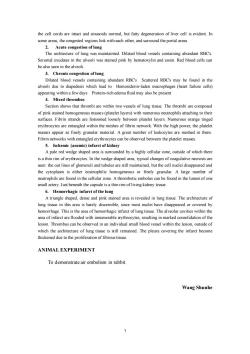
the cell cords are intact and sinusoids normal.but fatty degeneration of liver cell is evident.In ,the congested regions ink other,and the portal areas Acute congestion of lung The archtecture of lung was maintainted.Dilated blood vessels containing abundant RBCs Serumal exudates in the alveoli was stained pink by hematoxylin and eosin.Red blood cells can be also seen in the alveoli. 3.Chronic congestion of lung Dilated blood vessels containing abundant RBCs Scattered RBCs may be found in the alveoli due to diapedesis which lead to Hemosiderin-laden macrophages (heart failure cells) appearing within a few days Protein-rich edema fluid may also be present 4.Mixed thrombus Section shows that thrombi are within two vessels of lung tissue.The thrombi are composed surfaces.Fibrin strands are festooned loosely between platelet layers.Numerous orange tinge erythrocytes are entangled within the meshes of fibrin network With the high power.the platelet masses appear as finely granular material.A great number of leukocytes are meshed in them. Fibrin networks with entangled erythrocytes can be observed between the platelet masses. 5.Isch A pale red wedge shaped area is sumounded by a highly cellular zone,outside of which there is a thin rim of erythrocytes.In the wedge shaped area,typical changes of coagulative necrosis are seen:the out lines of glomeruli and tubules are still maintained,but the cell nuclei disappeared and the cytoplasm is either eosinophilic homogeneous or finely granular.A large number of ombotic embolus can be found in the lumen of one sule is a thin rim kidney tissue 6.Hemorrhagic infaret of the lung A triangle shaped.dense and pink stained area is revealed in lung tissue.The architecture of lung tissue in this area is barely discernible.since most nuclei have disappeared or covered by hemorrhage.This is the area of hemorrhagic infarct of lung tissue.The alveolar cavities within the area of in nfarct are flooded with ting in arked consolidatio be inan individual small blood the of which the architecture of lung tissue is still remained.The pleura covering the infarct become thickened due to the proliferation of fibrous tissue. ANIMAL EXPERIMENT To demonstrate air embolism in rabbit. Wang Shunhe
7 the cell cords are intact and sinusoids normal, but fatty degeneration of liver cell is evident. In some areas, the congested regions link with each other, and surround the portal areas. 2. Acute congestion of lung The archtecture of lung was maintainted. Dilated blood vessels containing abundant RBC's. Serumal exudates in the alveoli was stained pink by hematoxylin and eosin. Red blood cells can be also seen in the alveoli. 3. Chronic congestion of lung Dilated blood vessels containing abundant RBC's Scattered RBC's may be found in the alveoli due to diapedesis which lead to Hemosiderin-laden macrophages (heart failure cells) appearing within a few days Protein-rich edema fluid may also be present 4. Mixed thrombus Section shows that thrombi are within two vessels of lung tissue. The thrombi are composed of pink stained homogeneous masses (platelet layers) with numerous neutrophils attaching to their surfaces. Fibrin strands are festooned loosely between platelet layers. Numerous orange tinged erythrocytes are entangled within the meshes of fibrin network. With the high power, the platelet masses appear as finely granular material. A great number of leukocytes are meshed in them. Fibrin networks with entangled erythrocytes can be observed between the platelet masses. 5. Ischemic (anemic) infarct of kidney A pale red wedge shaped area is surrounded by a highly cellular zone, outside of which there is a thin rim of erythrocytes. In the wedge shaped area, typical changes of coagulative necrosis are seen: the out lines of glomeruli and tubules are still maintained, but the cell nuclei disappeared and the cytoplasm is either eosinophilic homogeneous or finely granular. A large number of neutrophils are found in the cellular zone. A thrombotic embolus can be found in the lumen of one small artery. Just beneath the capsule is a thin rim of living kidney tissue. 6. Hemorrhagic infarct of the lung A triangle shaped, dense and pink stained area is revealed in lung tissue. The architecture of lung tissue in this area is barely discernible, since most nuclei have disappeared or covered by hemorrhage. This is the area of hemorrhagic infarct of lung tissue. The alveolar cavities within the area of infarct are flooded with innumerable erythrocytes, resulting in marked consolidation of the lesion. Thrombus can be observed in an individual small blood vessel within the lesion, outside of which the architecture of lung tissue is still remained. The pleura covering the infarct become thickened due to the proliferation of fibrous tissue. ANIMAL EXPERIMENT To demonstrate air embolism in rabbit. Wang Shunhe
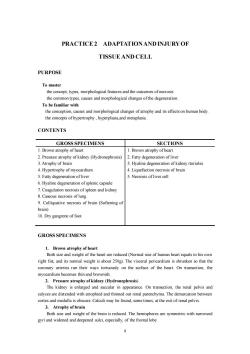
PRACTICE2 ADAPTATIONAND INJURY OF TISSUE AND CELL PURPOSE To master the types,morphological features and the the common types,causes and morphological changes of the degeneration To be familiar with the conception,causes and morphological changes of atrophy and its effectson human body. the concepts of hypertrophy,hyperplasia,and metaplasia. CONTENTS GROSS SPECIMENS SECTIONS 1.Brown atrophy ofheart 1.Brown atrophy of heart 2.Pressure atrophy of kidney (Hvdronephrosis) 2.Fatty degeneration of liver 3.Atrophy of brain 3.Hyaline degeneration of kidney rterioles n ne osis of brai 5.Fatty degeneration oflive 5.Necrosis of liver cell 6.Hyaline degeneration of splenic capsule 7.Coagulation necrosis of spleen and kidney 8 Caseous necrosis of lung 9.Colliquative necrosis of brain(Softening of brain) 10.Dry gangrene of foot GROSS SPECIMENS 1.Brown atrophy of hear Both size and weight of the heart are reduced(Normal size of human heart equals to his own right fist,and its normal weight is about 250g).The visceral pericardium is shrunken so that the coronary arteries run their ways tortuously on the surface of the heart.On transection.the myocardium becomes thin and brownish. 2.Pressure hy of kidney(Hydronephrosis) The kidney is enlarged and saccular in appearance.On transection,the renal pelvis and calyces are distended with atrophied and thinned out renal parenchyma.The demarcation between cortex and medulla is obscure.Calculi may be found,some times,at the exit of renal pelvis. 3.Atrophy of brain Both siz and eight of the brain isreduced.The hemispheres are symmetric with narrowed gyri and widened and deepened ,of the frontal obe
8 PRACTICE 2 ADAPTATION AND INJURY OF TISSUE AND CELL PURPOSE To master the concept, types, morphological features and the outcomes of necrosis the common types, causes and morphological changes of the degeneration. To be familiar with the conception, causes and morphological changes of atrophy and its effects on human body. the concepts of hypertrophy , hyperplasia,and metaplasia. CONTENTS GROSS SPECIMENS SECTIONS 1. Brown atrophy of heart 2. Pressure atrophy of kidney (Hydronephrosis) 3. Atrophy of brain 4. Hypertrophy of myocardium 5. Fatty degeneration of liver 6. Hyaline degeneration of splenic capsule 7. Coagulation necrosis of spleen and kidney 8. Caseous necrosis of lung 9. Colliquative necrosis of brain (Softening of brain) 10. Dry gangrene of foot 1. Brown atrophy of heart 2. Fatty degeneration of liver 3. Hyaline degeneration of kidney rterioles 4. Liquefaction necrosis of brain 5. Necrosis of liver cell GROSS SPECIMENS 1. Brown atrophy of heart Both size and weight of the heart are reduced (Normal size of human heart equals to his own right fist, and its normal weight is about 250g). The visceral pericardium is shrunken so that the coronary arteries run their ways tortuously on the surface of the heart. On transection, the myocardium becomes thin and brownish. 2. Pressure atrophy of kidney (Hydronephrosis) The kidney is enlarged and saccular in appearance. On transection, the renal pelvis and calyces are distended with atrophied and thinned out renal parenchyma. The demarcation between cortex and medulla is obscure. Calculi may be found, some times, at the exit of renal pelvis. 3. Atrophy of brain Both size and weight of the brain is reduced. The hemispheres are symmetric with narrowed gyri and widened and deepened sulci, especially, of the frontal lobe
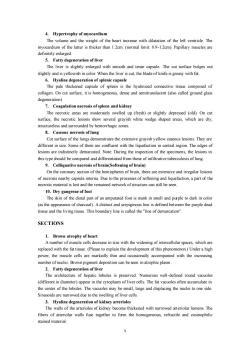
4.Hypertrophy of myocardium The voume and the weight of the heart increase with dilatation of the left ventricle.The myocardium of the latter is thicker than 1.2cm.(normal limit:09-1.2cm).Papillary muscles are definitely enlarged. 5.Fatty degeneration of liver The liver is slightly enlarged with smooth and tense capsule.The cut surface bulges out slightly and is the liver is cutthe blade of knife is greasy with fat Hyaline degeneration of splenic capsule The pale thickened capsule of spleen is the hyalinized connective tissue composed of collagen.On cut surface,it is homogeneous,dense and semitranslucent(also called ground glass degeneration) 7.Coagulation necrosis of spleen and kidney The necrotic areas are moderately swelled up (fresh)or slightly depressed (old)On cut surface,the necrotic lesions show several grayish white wedge shaped areas,which are dry. structureless and surrounded by hemorrhagic zones. 8.Caseous necrosis oflung Cut surface of the lungs demonstrates the extensive grayish yellow caseous lesions.They are e them with the liquefa central regi The edges esions are indistinctly demarcated.Note:During the inspection of,the esons in this type should be compared and differentiated from those of infiltrative tuberculosis of lung. 9.Colliquative necrosis of brain(Softening of brain) On the coronary section of the hemispheres of brain.there are extensive and irregular lesions ork of structure cans till be seer 10.Dry gangrene of foot The skin of the distal part of an amputated foot is stunk in smell and purple to dark in color (as the appearance of charcoal).Adistinct and serpiginous line is defined between the purple dead tissue and the living tissue.This boundaryine is called of demarcation" SECTIONS 1.Brown atrophy of heart Anumber of muscle cells decrease in size with the widening of intercellular spaces,which are replaced with the fat tissue.(Please to explain the development of this phenomenon)Under a high power.the muscle cells are markedly thin and occasionally accompanied with the increasing 2.Fatty degenera ation of liver The architecture of hepatic lobules is preserved.Numerous well-defined round vacuoles (different in diameter)appear in the cytoplasm of liver cells.The fat vacuoles often accumulate in the center of the lobules.The vacuoles may be small,large and displacing the nuclei to one side Sinusoids are narrowed due to the swelling ofliver cells 3.Hyaline degeneration of kidney arterioe The walls of the arterioles of kidney become thickened with narrowed arteriolar lumens.The fibers of arteriolar walls fuse together to form the homogeneous,refractile and eosinophilic stained material. 9
9 4. Hypertrophy of myocardium The volume and the weight of the heart increase with dilatation of the left ventricle. The myocardium of the latter is thicker than 1.2cm. (normal limit: 0.9-1.2cm). Papillary muscles are definitely enlarged. 5. Fatty degeneration of liver The liver is slightly enlarged with smooth and tense capsule. The cut surface bulges out slightly and is yellowish in color. When the liver is cut, the blade of knife is greasy with fat. 6. Hyaline degeneration of splenic capsule The pale thickened capsule of spleen is the hyalinized connective tissue composed of collagen. On cut surface, it is homogeneous, dense and semitranslucent (also called ground glass degeneration) 7. Coagulation necrosis of spleen and kidney The necrotic areas are moderately swelled up (fresh) or slightly depressed (old). On cut surface, the necrotic lesions show several grayish white wedge shaped areas, which are dry, structureless and surrounded by hemorrhagic zones. 8. Caseous necrosis of lung Cut surface of the lungs demonstrates the extensive grayish yellow caseous lesions. They are different in size. Some of them are confluent with the liquefaction in central region. The edges of lesions are indistinctly demarcated. Note: During the inspection of the specimens, the lesions in this type should be compared and differentiated from those of infiltrative tuberculosis of lung. 9. Colliquative necrosis of brain(Softening of brain) On the coronary section of the hemispheres of brain, there are extensive and irregular lesions of necrosis nearby capsula interna. Due to the processes of softening and liquefaction, a part of the necrotic material is lost and the remained network of structure can still be seen. 10. Dry gangrene of foot The skin of the distal part of an amputated foot is stunk in smell and purple to dark in color (as the appearance of charcoal). A distinct and serpiginous line is defined between the purple dead tissue and the living tissue. This boundary line is called the "line of demarcation". SECTIONS 1. Brown atrophy of heart A number of muscle cells decrease in size with the widening of intercellular spaces, which are replaced with the fat tissue. (Please to explain the development of this phenomenon.) Under a high power, the muscle cells are markedly thin and occasionally accompanied with the increasing number of nuclei. Brown pigment deposition can be seen in atrophic plasm . 2. Fatty degeneration of liver The architecture of hepatic lobules is preserved. Numerous well-defined round vacuoles (different in diameter) appear in the cytoplasm of liver cells. The fat vacuoles often accumulate in the center of the lobules. The vacuoles may be small, large and displacing the nuclei to one side. Sinusoids are narrowed due to the swelling of liver cells. 3. Hyaline degeneration of kidney arterioles The walls of the arterioles of kidney become thickened with narrowed arteriolar lumens. The fibers of arteriolar walls fuse together to form the homogeneous, refractile and eosinophilic stained material

4.Liquefaction necrosis of brain tisse debris ares Some scattered spongy like areas contain numerous macrophages or microglial cells.These cells phagocytose much lipid from necrotic white matter of brain tissue and, thus,are called"gitter cells"or"foamy cells" 5.Neerosis of liver cell (No.89) At the lower power,the structures of lobules are remained.At the high power,the nuclears of Wang Shunhe
10 4. Liquefaction necrosis of brain The brain tissue reveals that, in necrotic areas, the brain tissue undergoes liquefaction and the tissue debris are lost. Some scattered spongy like areas contain numerous macrophages or microglial cells. These cells phagocytose much lipid from necrotic white matter of brain tissue and, thus, are called "gitter cells" or "foamy cells." 5. Necrosis of liver cell (No.89) At the lower power,the structures of lobules are remained. At the high power,the nuclears of liver cells show pyknosis,karyolysis,or karyorrhexis. Wang Shunhe
按次数下载不扣除下载券;
注册用户24小时内重复下载只扣除一次;
顺序:VIP每日次数-->可用次数-->下载券;
- 重庆医科大学:《病理学》课程课程教学大纲 A Teaching Outline for Pathology Course.doc
- 重庆医科大学:《病理学》课程理论教学大纲(供七年制和五年制使用).doc
- 重庆医科大学:《病理学》课程教学资源(PPT课件)传染病与寄生虫病(infectious desease and parasitosis).ppt
- 重庆医科大学:《病理学》课程教学资源(PPT课件)神经系统疾病(Diseases of the CNS).ppt
- 重庆医科大学:《病理学》课程教学资源(PPT课件)内分泌系统疾病.ppt
- 重庆医科大学:《病理学》课程教学资源(PPT课件)女性生殖系统疾病(disease of female reproductive system and breast).ppt
- 重庆医科大学:《病理学》课程教学资源(PPT课件)泌尿系统疾病 Diseases of urinary system.ppt
- 重庆医科大学:《病理学》课程教学资源(PPT课件)消化系统疾病 Digestive system disease.ppt
- 重庆医科大学:《病理学》课程教学资源(PPT课件)呼吸系统疾病.ppt
- 重庆医科大学:《病理学》课程教学资源(PPT课件)心血管疾病 Diseases of Cardiovascular system.ppt
- 重庆医科大学:《病理学》课程教学资源(PPT课件)肿瘤(tumor, neoplasm).ppt
- 重庆医科大学:《病理学》课程教学资源(PPT课件)炎症 inflammation.ppt
- 重庆医科大学:《病理学》课程教学资源(PPT课件)局部血液循环障碍.ppt
- 重庆医科大学:《病理学》课程教学资源(PPT课件)绪论、细胞和组织的适应与损伤、损伤的修复.ppt
- 《病理学》课程作业习题(含参考答案).pdf
- 《病理学》课程实习指导 Guidance of Pathology.pdf
- 《病理学》课程教学大纲(五年制临床、儿科、麻醉、基础、预防、口腔医学专业使用;七年制临床、儿科、检验、物理专业使用).docx
- 《遗传与优生学》课程教学资源(课件讲稿)第8章 遗传咨询(genetic counseling).pdf
- 《遗传与优生学》课程教学资源(课件讲稿)第7章 肿瘤遗传学.pdf
- 《遗传与优生学》课程教学资源(课件讲稿)第6章 分子病(molecular disease).pdf
- 重庆医科大学:《病理学》课程作业习题(英文,无答案).doc
- 重庆医科大学:《病理学》课程英文试卷(试题).doc
- 重庆医科大学:《病理学》课程英文试卷(答案).doc
- 重庆医科大学:《病理学》课程教学资源(授课教案)infectious disease.doc
- 重庆医科大学:《病理学》课程教学资源(授课教案)the Diseases of female genital system.doc
- 重庆医科大学:《病理学》课程教学资源(授课教案)disease of nevous system_1.doc
- 重庆医科大学:《病理学》课程教学资源(授课教案)disease of nevous system_2.doc
- 重庆医科大学:《病理学》课程教学资源(授课教案)diseases of cardiovascular system.doc
- 重庆医科大学:《病理学》课程教学资源(授课教案)diseases of respiratory system.doc
- 重庆医科大学:《病理学》课程教学资源(授课教案)disease of alimentary system.doc
- 重庆医科大学:《病理学》课程教学资源(授课教案)disease of urinary system.doc
- 重庆医科大学:《病理学》课程教学资源(授课教案)cell adaptation and injury, repair.doc
- 重庆医科大学:《病理学》课程教学资源(授课教案)tumor.doc
- 重庆医科大学:《病理学》课程教学资源(授课教案)Introduction and hemodynamic rearangment.doc
- 重庆医科大学:《病理学》课程教学资源(授课教案)inflammation.doc
- 重庆医科大学:《病理学》课程教学资源(授课教案)内分泌系统疾病.doc
- 重庆医科大学:《病理学》课程教学资源(授课教案)传染和寄生虫病.doc
- 重庆医科大学:《病理学》课程教学资源(授课教案)女性生殖系统疾病.doc
- 重庆医科大学:《病理学》课程教学资源(授课教案)神经系统疾病.doc
- 重庆医科大学:《病理学》课程教学资源(授课教案)心血管系统疾病.doc
